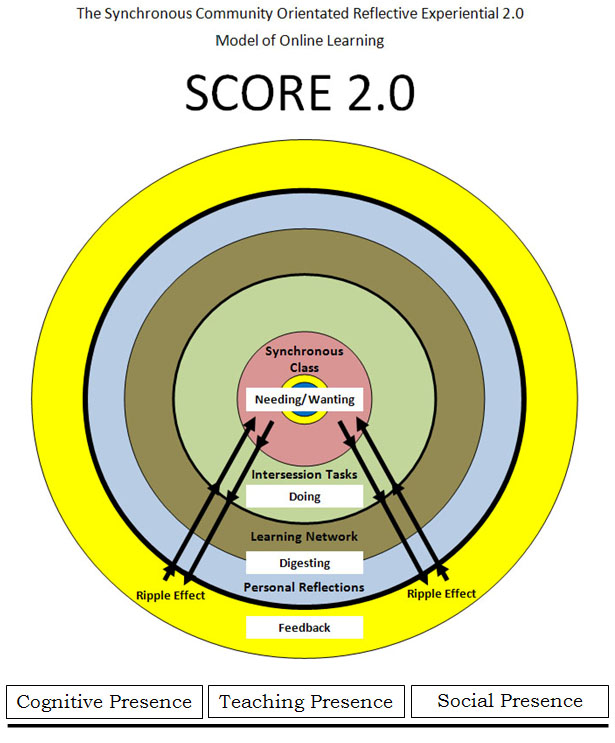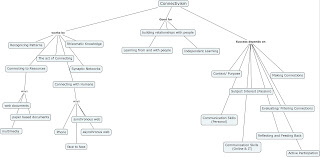Background
The field of interest that I work in is teaching and learning. My focus is primarily on distance learning, but I still do some face to face teaching. In the UK new teachers in Higher Education in the last 10 years or so are encouraged to complete a postgraduate teaching certificate on professional and higher education where they are exposed, at the least to the concepts of small group work, experiential learning, reflection, the integration of learning outcomes, learning activities and assessment and the importance of formative as well as summative feedback. I would say that on the whole participants on these courses are much wiser and more aware of teaching methods other than the straightforward unengaging lectures that may have been more the norm twenty years ago.
What a lot of current modern day teachers in higher education may not be aware of is the affordances of modern day social software tools and the powerful learning potential for students when they participate, collaborate, share, create, re-invent and connect. McGee and Diaz (2007) note that:
“applications defined as ‘Web 2.0’ hold the most promise [for teaching and learning] because they are strictly web based and typically free, support collaboration and interaction and are responsive to the user. These applications have great potential to be used in way that is learner-centred, affordable and accessible for teaching and learning purposes.” (McGee and Diaz 2007, p. 32)[i]
Additionally, as a by product of these social software tools there is vastly more knowledge and ways to access this knowledge which means the role of educators do need to change i) to reflect the societal and technological changes that have taken place in recent times and ii) because these new tools can enhance learning.
What to do? – Appropriate Response and overcoming impediments to change
Teacher training has to be at the forefront of any responses. This will be led from the grass roots until such times decision makers finally see the value to the business, the students and the teachers. Once recognised and valued as part of an organisations strategic plan, more official time can be allocated to staff development and help with by easing the pressure on staff to integrate new methods into there already demanding workload, The importance of this approach is underlined in section 3, ‘the value of educator professional development’ in the ‘teaching the teacher’ video from the e-learning for educators Missouri website:
In short for unenlightened institutions, impediments to change revolves around a lack of understanding of decision makers of the potential of new technologies and new ways of teaching and learning. Additionally a lack of understanding on how new technologies can be employed to change working, communication and dissemination practices means that many cultures within higher education institutions have not evolved to take advantages of new attitudes and new ways of working.
One response that can impact on both cultural change and speed the development of teachers into using new technologies within their own teaching and learning is to adopt IT systems that promote a social networking mentality amongst users, as opposed to the widespread clunky content management systems. Angel LMS is an example of how an institution might like to tie it’s administrative and management objectives to an IT system that is more likely to change the culture of institution to a social learning networked environment:
I have no first hand experience of the system myself but I am suitably impressed with what the author Tony Seuss has to say. Combining the theme of cultural change and teacher training is the Cloudworks project led by Conole (2008)[ii]. Using a social networking principle as a means of communication and interaction Conole (2008) explains:
“Cloudworks allows you to find other people's learning and teaching ideas, designs and experiences as well as sharing your own. You can also get access to many learning design tools and resources to help you create learning designs.” Cloudworks website (2008)[iii]
In terms of actually changing the mindset of reluctant or time poor teachers the most effective way is for teachers to get hands on experience and therefore the proposal of Bowskill (2004) [iv of using informal learning projects as a vehicle for collaborative professional development in online communities is an attractive approach in enabling teachers to swap ideas and get practical hands on experience.
Ripples – combining an existing learning metaphor, that utilises new technology to embrace social and active learning
My own experience and studies into Web 2.0 tools and online synchronous classrooms (web conferencing meeting rooms) is that by the using these tools to run professional development courses on the very subject of ‘web 2.0 (social software) tools for teaching and learning’, a powerful way is found of teachers gaining practical hands on experience and becoming wise to a new mentality of learning i.e. participating, sharing, contributing, collaborating, externalizing.
To combine general good teaching and learning practices with new technologies I have devised and implemented a model of learning for distance learners which is conceptually aligned with Race’s (2001)[v] Ripples model of learning, with an online synchronous class (could be a face to face class) and the facilitating teacher at the core promoting social interaction, practical active online tasks and the notion of a community. Web 2.0 tools are used outside the class to assist the building of community, development of practical skills, reflections on learning, the giving and receiving of feedback and to develop the autonomous learning skills of the learner. The role of the facilitating teacher leading this course or other courses in this style is to simultaneously support and help students whilst developing their ability to work with others and be a confident autonomous self directed learner. The Model has been named the Synchronous Community Orientated Reflective and Experiential 2.0 (
SCORE 2.0) Model.

I have initially posted information about this approach on an earlier blog post (
SCORE 2.0) and I am working with a colleague to publish more formally on this approach soon. Initial feedback on user engagement and satisfaction with learning has been good.
Conclusion
Methods that give practical experience in the use of social software tools to teachers, administrators and decision makers will speed the process of uptake both in teaching and learning and in developing a learning, participative culture. Institutions slow to recognize and cultivate social networking cultures will eventually suffer a competitive disadvantage.
References
[iii] Cloudworks website(2008) Inspiration for creating new learning activities? [retrieved 10/11/08]
http://cloudworks.ac.uk







